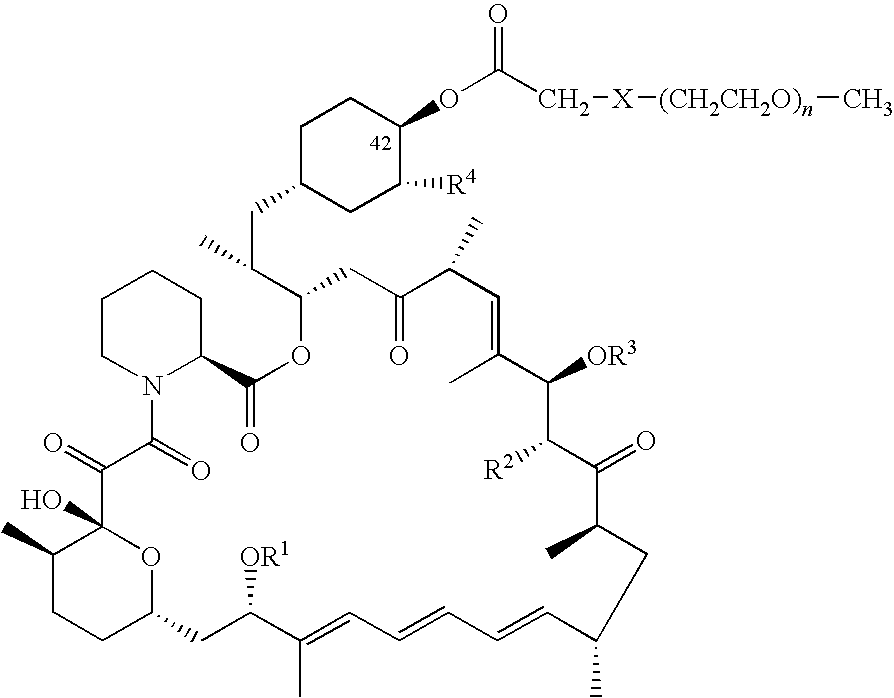Processes for preparing water-soluble polyethylene glycol conjugates of macrolide immunosuppressants
a technology of immunosuppressant and water-soluble polyethylene glycol, which is applied in the field of process of preparing water-soluble polyethylene glycol conjugates of macrolide immunosuppressants, can solve the problems of limited clinical applications of rapamycin, low selectivity of ester linkage installation, and complicated formulation
- Summary
- Abstract
- Description
- Claims
- Application Information
AI Technical Summary
Benefits of technology
Problems solved by technology
Method used
Image
Examples
example 1
Preparation of PEG-Rapamycin Conjugate (I) through Rapamycin 42-bromoacetate (VII)
[0082]
A. Preparation of Rapamycin 42-bromoacetate (VII)
[0083]A mixture of rapamycin (914 mg, 1 mmol), vinyl bromoacetate (660 mg, 4 mmol), 5 Å molecular sieves (100 mg) and Novozym 435™ lipase (1.0 g) in anhydrous t-butyl methyl ether (TBME) (8 mL) was heated under N2 at 40° C. for 8 hours. The enzyme was removed by filtration and washed with TBME. The mixture was concentrated and precipitated into hexane. The rapamycin 42-bromoacetate (VII) was collected by filtration and dried in vacuo. Yield: 1.01 g (98%). MS (ESI) m / e 1035 (M−)
B. Preparation of PEG-Rapamycin Conjugate (I)
[0084]To a solution of mPEGSH (500 mg, MW=5000) in MeCN (1.5 mL) was added diisopropylethylamine (17 mg), followed by rapamycin 42-bromoacetate (VII) (95 mg). The mixture was then stirred at room temperature for 3 hours. 2-propanol (18 mL) was added and the mixture was cooled to 10-15° C. and held for 30 minutes. The precipitated p...
example 2
Preparation of PEG-everolimus Conjugate (II) Through Everolimus 42-bromoacetate (VIII)
[0086]
A. Preparation of Everolimus 42-bromoacetate (VIII)
[0087]A mixture of everolimus (250 mg, 0.26 mmol), vinyl bromoacetate (165 mg, 1 mmol), 5 Å molecule sieves (20 mg), and Novozym 435™ lipase (200 mg) in anhydrous t-butyl methyl ether (TBME) (3 mL) was heated under N2 at 35° C. for 10 hours. The enzyme was removed by filtration and washed with TBME. The mixture was concentrated and triturated with hexane. The everolimus 42-bromoacetate (VIII) was collected by filtration and dried in vacuo. Yield: 275 mg (96%). MS (ESI) m / e 1078 (M−)
B. Preparation of PEG-everolimus Conjugate (II)
[0088]To a solution of mPEGSH (500 mg, MW=5000) in MeCN (1.5 mL) was added diisopropylethylamine (18 mg), followed by everolimus 42-bromoacetate (VII) (110 mg). The mixture was then stirred at room temperature for 3 hours. 2-propanol (18 mL) was added over 10 minutes and the mixture was cooled to 10-15° C. and held for...
example 3
Preparation of CCI-779 mono-bromoacetate (IX) and CCI-779 bis-bromoacetate (X)
[0089]
[0090]A mixture of CCI-779 (7.0 g, 6.8 mmol), vinyl bromoacetate (4.0 g, 24.24 mmol), 5 Å molecule sieves (2.0 g), and Novozym 435™ lipase (1.3 g) in anhydrous t-butyl methyl ether (TBME) (130 mL) was stirred at room temperature under N2 for 8 hours. HPLC showed that the reaction mixture contained 64% mono-bromoacetate, 20% bis-bromoacetate and 12% CCI-779 starting material. The enzyme was removed by filtration and washed with TBME. The mixture was concentrated and purified by silica gel chromatography. The less polar fraction contained bis-bromoacetate (X) and was collected (1.41 g). MS (ESI) m / e 1317 (M+45)−. The more polar fraction contained mono-bromoacetate (IX) (4.56 g), which was then isolated as a white powder. MS (ESI) m / e 1196 (M+45)−.
PUM
| Property | Measurement | Unit |
|---|---|---|
| solubility | aaaaa | aaaaa |
| structure | aaaaa | aaaaa |
| structures | aaaaa | aaaaa |
Abstract
Description
Claims
Application Information
 Login to View More
Login to View More - R&D
- Intellectual Property
- Life Sciences
- Materials
- Tech Scout
- Unparalleled Data Quality
- Higher Quality Content
- 60% Fewer Hallucinations
Browse by: Latest US Patents, China's latest patents, Technical Efficacy Thesaurus, Application Domain, Technology Topic, Popular Technical Reports.
© 2025 PatSnap. All rights reserved.Legal|Privacy policy|Modern Slavery Act Transparency Statement|Sitemap|About US| Contact US: help@patsnap.com



